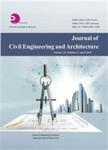Curling of New Concrete Pavement and Long-Term Performance
Curling of New Concrete Pavement and Long-Term Performance作者机构:University of North Dakota 243 Centennial Dr Stop 8115 Grand Forks ND 58202-8115 USA Department of Civil Engineering 2118 Fiedler Hall Kansas State University Manhattan KS 66506 USA ARCAD1S LNW 420 Columbia Drive Suite 110 West Palm Beach FL 33409 USA FHWA Kansas Division 6111 SW 29th St. Topeka KS 66614 USA Bureau of Materials & Research Kansas Department of Transportation 2300 Van Buren Topeka KS 66611 USA
出 版 物:《Journal of Civil Engineering and Architecture》 (土木工程与建筑(英文版))
年 卷 期:2012年第6卷第2期
页 面:121-130页
学科分类:08[工学] 0814[工学-土木工程] 081201[工学-计算机系统结构] 082301[工学-道路与铁道工程] 0812[工学-计算机科学与技术(可授工学、理学学位)] 0823[工学-交通运输工程]
主 题:Curling HIPERPAVII long-term performance MEPDG.
摘 要:Curling results from the temperature differential across the concrete slab thickness and may induce undue stresses in newly placed slab. This study deals with the finite element (FE) analysis of curling, curling stresses, field measurement of curling on a newly built jointed plain concrete pavement, and comparison of its long-term performance using both Mechanistic-Empirical Pavement Design Guide (MEPDG) and HIPERPAVII software. The FE analysis was performed with a software program, ANSYS. The test section was modeled as a three-layer system with 300 mm concrete slab, 100 mm treated drainable base, and 150 mm lime-treated subgrade. All layers were assumed to be linear elastic. Temperature data was collected at five different depth locations across the concrete slab with digital data loggers. Curling was measured on five different days with a simple setup. The effect of temperature nonlinearities across the slab thickness was also examined. The results show that both upward and downward curling increase as the temperature differential increases. The maximum stress resulting from the combined effect of curling and traffic loading due to positive temperature differential is higher than that due to the negative temperature differential of the same magnitude. Since temperature differential has a significant influence on curling, both curling and curling stresses can be mitigated at an early age with temperature control, namely via enhanced curing. Both MEPDG and HIPERPAVII showed approximately the same performance for the PCC thickness ranging from 215 mm to 300 mm for this project. Performance prediction from HIPERPAVII is very sensitive to the change in PCC thickness less than 230 mm whereas MEPDG prediction is not as sensitive to the thickness change as with HIPERPAV 1I.



